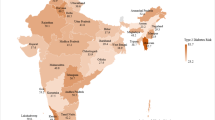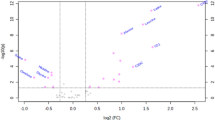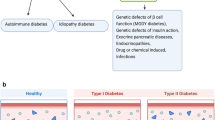Abstract
Background/Objectives:
Oxidative stress may induce insulin resistance in peripheral tissues and impair insulin secretion from pancreatic β-cells. Antioxidants are suggested to decrease the risk of diabetes through reduction of oxidative stress. However, only a few studies exist on dietary antioxidants and the risk of type 2 diabetes. We investigated the association of dietary antioxidants with incident type 2 diabetes in the α-Tocopherol, β-Carotene Cancer Prevention Study cohort.
Subject/Methods:
The study cohort included 29 133 male smokers aged 50–69 years. During a median follow-up of 10.2 years 660 incident cases of diabetes were observed among the 25 505 men with a completed baseline food frequency questionnaire.
Results:
Dietary α-tocopherol, β-tocopherol and β-tocotrienol were positively associated with the risk of diabetes when adjusted for age and supplementation (relative risk (RR) 1.17 (95% confidence interval (CI) 0.91–1.51) P for trend 0.02; RR 1.31 (95% CI 1.02–1.68) P for trend 0.01; RR 1.28 (95% CI 1.00–1.63) P for trend 0.01, respectively), but the association disappeared after multivariate adjustment (RR 0.92 (95% CI 0.71–1.19) P for trend 0.97; RR 1.06 (95% CI 0.82–1.36) P for trend 0.48; RR 1.04 (95% CI 0.80–1.35) P for trend 0.46, respectively). Other tocopherols and tocotrienols as well as vitamin C, carotenoids, flavonols and flavones had no association with risk of diabetes.
Conclusions:
Dietary antioxidants were not associated with a decreased risk of incident diabetes in middle-aged male smokers.
This is a preview of subscription content, access via your institution
Access options
Subscribe to this journal
Receive 12 print issues and online access
$259.00 per year
only $21.58 per issue
Buy this article
- Purchase on SpringerLink
- Instant access to full article PDF
Prices may be subject to local taxes which are calculated during checkout
Similar content being viewed by others
References
Akbaraly TN, Fontbonne A, Favier A, Berr C (2008). Plasma carotenoids and onset of dysglycemia in an elderly population: results of the Epidemiology of Vascular Ageing Study. Diabetes Care 31, 1355–1359.
Arnlöv J, Zethelius B, Risérus U, Basu S, Berne C, Vessby B et al. (2009). Serum and dietary beta-carotene and alpha-tocopherol and incidence of type 2 diabetes mellitus in a community-based study of Swedish men: report from the Uppsala Longitudinal Study of Adult Men (ULSAM) study. Diabetologia 52, 97–105.
Ceriello A, Motz E (2004). Is oxidative stress the pathogenic mechanism underlying insulin resistance, diabetes, and cardiovascular disease? The common soil hypothesis revisited. Arterioscler Thromb Vasc Biol 24, 816–823.
Dembinska-Kiec A, Mykkänen O, Kiec-Wilk B, Mykkänen H (2008). Antioxidant phytochemicals against type 2 diabetes. Br J Nutr 99 (E-Suppl), 109–117.
Dempster AP, Laird NM, Rubin DB (1977). Maximum likelihood from incomplete data via the EM algorithm. J R Stat Soc Ser B Methodol 39, 1–38.
Ford ES (2001). Vitamin supplement use and diabetes mellitus incidence among adults in the United States. Am J Epidemiol 153, 892–897.
Häkkinen SH, Kärenlampi SO, Heinonen IM, Mykkänen HM, Törrönen AR (1999). Content of the flavonols quercetin, myricetin and kampherol in 25 edible berries. J Agric Food Chem 47, 2274–2279.
Hamer M, Chida Y (2007). Intake of fruit, vegetables and antioxidants and risk of type 2 diabetes: systematic review and meta-analysis. J Hypertens 25, 2361–2369.
Harding AH, Wareham NJ, Bingham SA, Khaw K, Luben R, Welch A et al. (2008). Plasma vitamin C level, fruit and vegetable consumption, and the risk of new-onset type 2 diabetes mellitus: the European prospective investigation of cancer-Norfolk prospective study. Arch Intern Med 168, 1493–1499.
Heinonen M (1990). Carotenoids and Retinoids in Finnish Foods and the Average Diet. Helsinki University: Helsinki, Finland.
Hertog MG, Hollman PC, Katan MB (1992). Content of potentially anticarcinogenic flavonoids of 28 vegetable and 9 fruits commonly consumed in the Netherlands. J Agric Food Chem 40, 2379–2383.
Hertog MG, Hollman PC, van de Putte P (1993). Content of potentially anticarcinogenic flavonoids in tea infusions, wines and fruit juices. J Agric Food Chem 41, 1242–1246.
Kataja-Tuomola M, Sundell JR, Männistö S, Virtanen MJ, Kontto J, Albanes D et al. (2008). Effect of α-tocopherol and β-carotene supplementation on the incidence of type 2 diabetes. Diabetologia 51, 47–53.
Knekt P, Kumpulainen J, Järvinen R, Rissanen H, Heliövaara M, Reunanen A et al. (2002). Flavonoid intake and risk of chronic diseases. Am J Clin Nutr 76, 560–568.
Knekt P, Reunanen A, Marniemi J, Leino A, Aromaa A (1999). Low vitamin E status is a potential risk factor for insulin-dependent diabetes mellitus. J Intern Med 245, 99–102.
Laakso M, Pyörälä K (1985). Age of onset and type of diabetes. Diabetes Care 8, 114–117.
Liu S, Ajani U, Chae C, Hennekens C, Buring JE, Manson JE (1999). Long-term beta-carotene supplementation and risk of type 2 diabetes mellitus: a randomized controlled trial. JAMA 282, 1073–1075.
Liu S, Lee IM, Song Y, Van Denburgh M, Cook NR, Manson JE et al. (2006). Vitamin E and risk of type 2 diabetes in the Women′s Health Study randomized controlled trial. Diabetes 55, 2856–2862.
Lonn E, Yusuf S, Hoogwerf B, Pogue J, Yi Q, Zinman B et al. (2002). Effects of vitamin E on cardiovascular and microvascular outcomes in high-risk patients with diabetes: results of the HOPE study and MICRO-HOPE substudy. Diabetes Care 25, 1919–1927.
Manning PJ, Sutherland WH, Walker RJ, Williams SM, De Jong SA, Ryalls AR et al. (2004). Effect of high-dose vitamin E on insulin resistance and associated parameters in overweight subjects. Diabetes Care 9, 2166–2171.
Mayer-Davis EJ, Costacou T, King I, Zaccaro DJ, Bell RA (2002). Plasma and dietary vitamin E in relation to incidence of type 2 diabetes: the Insulin Resistance and Atherosclerosis Study (IRAS). Diabetes Care 25, 2172–2177.
Montonen J, Knekt P, Järvinen R, Reunanen A (2004). Dietary antioxidant intake and risk of type 2 diabetes. Diabetes Care 27, 362–366.
Nettleton JA, Harnack LJ, Scrafford CG, Mink PJ, Barraj LM, Jacobs DR (2006). Dietary flavonoids and flavonoid-rich foods are not associated with risk of type 2 diabetes in postmenopausal women. J Nutr 136, 3039–3045.
Newsholme P, Haber EP, Hirabara SM, Rebelato ELO, Procopio J, Morgan D et al. (2007). Diabetes associated cell stress and dysfunction: role of mitochondrial and non-mitochondrial ROS production and activity. J Physiol 583, 9–24.
Paolisso G, D′Amore A, Giugliano D, Ceriello A, Varricchio M, D′Onofrio F (1993). Pharmacologic doses of vitamin E improve insulin action in healthy subjects and non-insulin-dependent diabetic patients. Am J Clin Nutr 57, 650–656.
Pietinen P, Hartman AM, Haapa E, Räsänen L, Haapakoski J, Palmgren J et al. (1988). Reproducibility and validity of dietary assessment instruments. I. A self-administered food use questionnaire with a portion size picture booklet. Am J Epidemiol 128, 655–666.
Piironen V (1986). Tocopherols and Tocotrienol in Foods and in the Average Diet. Helsinki University: Helsinki, Finland.
R Development Core Team (2009). R: A Language and Environment for Statistical Computing. R Foundation for Statistical Computing: Vienna, Austria.
Report of a WHO Consultation (1999). Definition, Diagnosis and Classification of Diabetes Mellitus and its Complications. Part I: Diagnosis and Classification of Diabetes Mellitus, World Health Organization, Department of Noncommunicable Disease Surveillance: Geneva.
Reunanen A, Knekt P, Aaran RK, Aromaa A (1998). Serum antioxidants and risk of non-insulin dependent diabetes mellitus. Eur J Clin Nutr 52, 89–93.
Rizzo MR, Abbatecola AM, Barbieri M, Vietri MT, Cioffi M, Grella R et al. (2008). Evidence for anti-inflammatory effects of combined administration if vitamin E and C in older persons with impaired fasting glucose: impact on insulin action. J Am Coll Nutr 27, 505–511.
Robertson R, Zhou H, Zhang T, Harmon JS (2007). Chronic oxidative stress as a mechanism for glucose toxicity of the beta cell in type 2 diabetes. Cell Biochem Biophys 48, 139–146.
Song Y, Cook NR, Albert CM, Van Denburgh M, Manson JE (2009). Effects of vitamins C and E and beta-carotene on the risk of type 2 diabetes in women at high risk of cardiovascular disease: a randomized controlled trial. Am J Clin Nutr 90, 429–437.
Song Y, Manson JA, Buring JE, Sesso HD, Liu S (2005). Associations of dietary flavonoids with risk of type 2 diabetes, and markers of insulin resistance and systemic inflammation in women: a prospective study and cross-sectional analysis. J Am Coll Nutr 24, 376–384.
The Alpha-Tocopherol, Beta-Carotene Cancer Prevention Study Group (1994). The effect of vitamin E and beta carotene on the incidence of lung cancer and other cancers in male smokers. N Engl J Med 330, 1029–1035.
The ATBC Cancer Prevention Study Group (1994). The alpha-tocopherol, beta-carotene lung cancer prevention study: design, methods, participant characteristics, and compliance. Ann Epidemiol 4, 1–10.
Vincent HK, Bourguignon CM, Weltman AL, Vincent KR, Barrett E, Innes KE et al. (2009). Effects of antioxidant supplementation on insulin sensitivity, endothelial adhesion molecules, and oxidative stress in normal-weight and overweight young adults. Metabolism 58, 254–262.
Wang L, Liu S, Manson JA, Gaziano JM, Buring JE, Sesso HD (2006a). The consumption of lycopene and tomato-based food products is not associated with the risk of type 2 diabetes in women. J Nutr 136, 620–625.
Wang L, Liu S, Pradhan AD, Manson JA, Buring JE, Gaziano JM et al. (2006b). Plasma lycopene, other carotenoids, and the risk of type 2 diabetes in women. Am J Epidemiol 164, 576–585.
Willett W, Stampfer MJ (1986). Total energy intake: implications for epidemiologic analyses. Am J Epidemiol 124, 17–27.
Ylihärsilä H, Lindström J, Eriksson JG, Jousilahti P, Valle TT, Sundvall J et al. (2005). Prevalence of diabetes and impaired glucose regulation in 45- to 64-year-old individuals in three areas of Finland. Diabet Med 22, 88–91.
Acknowledgements
The ATBC Study was supported by US Public Health Service contracts N01-CN-45165, N01-RC-45035 and N01-RC-37004 from the National Cancer Institute, NIH and the Department of Health and Human Services.
Author information
Authors and Affiliations
Corresponding author
Ethics declarations
Competing interests
The authors declare no conflict of interest.
Additional information
Contributors: MKKT contributed to the study design, data collection and interpretation and manuscript writing. JPK contributed to data analysis and manuscript review. SM contributed to the study design, data interpretation and manuscript review. DA contributed to the manuscript review. JV contributed to project planning and coordinating, study design, data interpretation and manuscript review.
Rights and permissions
About this article
Cite this article
Kataja-Tuomola, M., Kontto, J., Männistö, S. et al. Intake of antioxidants and risk of type 2 diabetes in a cohort of male smokers. Eur J Clin Nutr 65, 590–597 (2011). https://doi.org/10.1038/ejcn.2010.283
Received:
Revised:
Accepted:
Published:
Issue date:
DOI: https://doi.org/10.1038/ejcn.2010.283



